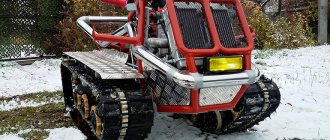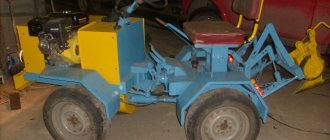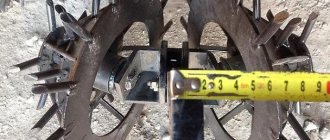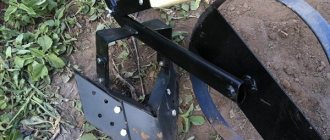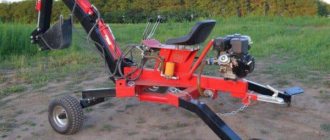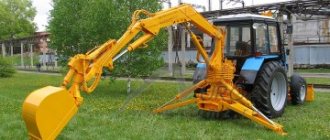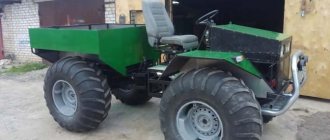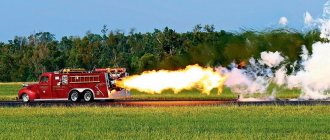A modern “Ant”, assembled according to the drawings of the “Modelist-Constructor” magazine.
Despite the two decades that separate today from the rich Soviet past, the seeds of extraordinary, creative ideas still sprout in the field of modern capitalism and sometimes bear good fruit. Our country inherited homemade trucks as a tradition, because in the modern world, the car and the driver are separated by the most complex mechanical engineering technology, electronics, and numerous and expensive tools. And the products of the Soviet automobile industry pushed the driver to modernize, although not always effective, but with a completely understandable design, practicality of the device, and ease of modernization.
A truck with an IZH engine: from the Volga and Moskvich-407 cars, it is proposed to take semi-elliptical springs, having first shortened them, and make the rear suspension spring, independent.
Just remember the now famous products of the Tula Machine-Building Plant under the unassuming name “Ant”. One type of this wheeled vehicle makes one think about making a flatbed truck based on a scooter. By the way, the first “Ant” (not TG-200) was assembled by hand in 1966 by home-made workers Ivchenko and Molchanov. The Java-350 engine located behind the rear axle made it possible to lower the center of gravity and, together with the carriage layout, make the body more stable on the road. With a power of 14.3 hp. (4500 rpm), this homemade mini-truck developed up to 70 km/h, and its diagrams were published in the “Modelist-Konstruktor” magazine for the 70th year.
And indeed: scrapped mopeds and motorcycles are the basis for most of these crafts. This is probably due to the fact that the design of a moped is easiest to adapt to everyday needs: there is no need to tinker with a complex transmission - you attach the body and go. Homemade mini trucks are assembled not to admire them as a work of art (although this also occurs), but because this type of transport is a wonderful assistant in the household.
General principle
Most often, the base of a homemade mini-truck consists of a welded tubular frame, in the central part of which there is an engine. The motor can be removed from any old motorcycle or moped. The cabin is made from parts of old cars. Since all transmission parts are usually borrowed from other cars, the control levers and pedals are usually located on the right side of the cabin.
Wheels are most often combined (processed machine wheels, with motorcycle wheels or even cart wheels). Masters of such homemade designs for helmsmen recommend using motorcycle and scooter tires. Wheels are selected depending on the driving conditions. Homogeneous and dual wheels are suitable for smooth, unproblematic roads. While wide-profile motorcycle tires are suitable for off-road driving or simply difficult sections of the road.
The homemade truck is driven by an engine from a walk-behind tractor without a muffler, the body is made of lumber, and the wheels are made of low-pressure tires. The disadvantages of the design are front-wheel drive and heavy steel wheels.
The easiest way to assemble a homemade truck body is from lumber: they are inexpensive and do not require any special equipment for installation. Of course, the body can be removed from a tractor or any other vehicle, but you need to take into account its weight and dimensions - such a body is subject to modification. A good welding machine opens up wide possibilities, the presence of which makes it possible to weld a body frame in the garage.
More on the topic: Identify sleep disorders in truck drivers
Mini truck from a creator from Canada
Not only in our country there are craftsmen who can create a homemade truck from a variety of car parts literally from a landfill.
Mini truck from a creator from Canada
This is exactly what a man from Canada did. His car turned out to be very interesting and original. The engine and gearbox were borrowed for the mini-truck from an old Volkswagen Golf.
The self-made cabin is located above the engine, and the frame is made of square pipes and angles. The frame is covered with thin steel sheets.
Mini truck from a creator from Canada
The American homemade truck has a tipper body; it is lifted using a hydraulic system. It is made of a hydraulic pump and a cylinder. The body can accommodate cargo up to one ton.
Frame for a homemade truck
In the general stream of frame structures offered by modern Kulibins, one can distinguish breakable and monolithic frames. The idea of a breakable frame pursues two goals at once - achieving high mobility and combining elements of different cars in one design. So the frame consists of two parts, connected to each other by a hinge. The latter is most often a universal joint removed from another truck. However, such a mount can move in any direction, and its degrees of freedom must first be limited to “right-left” by welding lugs to the edges of the cardan cross.
For greater maintainability and reliability, it is recommended to look for ready-made automobile frames, for example from GAZ-51, and more often than other passenger cars you can see a converted one in the drawings and diagrams
. The diagram below shows a drawing of a homemade truck from Ryazan. For obvious reasons, it cannot be classified as a “mini”, but the principle of maximum use of factory components should be noted. This type of equipment is a real construction set, on the basis of which you can build trucks even in your own garage. On this car, not only the frame is taken from the GAZ-51, but also the suspension from the same car.
A master from Ryazan cut out the middle cross member from the frame of a GAZ-51 car. The cardan and rear axle have been shortened, but the front axle has not undergone any changes.
The frame was shortened by 90 cm by removing the middle part, along with one of the cross members. To strengthen the welding, overlays made of sheets 4 mm thick were used. This modification turned out to be necessary in order to avoid reworking the towbar and finding a point for attaching the springs. The disadvantage of this approach is the need to shorten the driveshaft, rear axle and axle shafts. The author also had to reduce the track: the “stockings” from the crankcase were shortened by 88 mm (at the same time, new “factory” grooves had to be applied to them and separated from the crankcase).
The main materials for homemade frames are channels with numbers from 6.5P to 10P, cylindrical and square pipes 40x40, 80x80, etc. It is recommended to strengthen the welding site with additional pads, especially in places where elements such as springs are attached. Less significant parts are reinforced with ordinary metal corners, rods, etc. V. Mikhailov and the Chelyabinsk region for the basis of his truck (
,
,
) took the frame from a mobile pumping station. At the same time, the master reminds that the width of the frame is calculated from the width of the axles, the diameter and angle of rotation of the front wheels, and that when choosing the length of the frame, it is more logical to start from the base (the distance between the axles), and not vice versa.
This video shows a homemade truck from Canada. The original cabin and frame are assembled from scrap materials (thin steel, pipes and angles). But no less interesting is the location of the Volkswagen engine, which stood transversely on the original chassis.
STRONG BUT LIGHTWEIGHT
0
Source:
See all photos in the gallery
The first Soviet pickup truck was the 1932 NATI-2. The prototype of this car was made at the same time as a convertible and a roadster. People's cars with 22-horsepower engines were planned for production in Izhevsk to replace the simple NAMI-1, which was assembled semi-handicraft in small quantities in Moscow. It didn't come true...
0
Source:
But a year later, in 1933, the Gorky Automobile Plant began mass production of the GAZ-4 pickup truck with a declared load capacity of half a ton. Following this car, built on the GAZ-A basis, a cargo version of the Emka, the GAZ-M415 with a carrying capacity of 400 kg, went into production. It’s interesting that the first Soviet pickups were closer not to their modern counterparts, but rather to... station wagons without a roof. After all, in the bodies of GAZ vehicles along the sides there were folding benches for six passengers. Surprisingly, this design (albeit in a slightly different form) will return to the Soviet automobile industry half a century later. In the meantime, in the 1930s, homemade booths were sometimes installed on pickup trucks, making the vehicles vans, and some small businesses created their own versions (somewhat ugly, and sometimes quite attractive) of light-duty vehicles.
×
0
Source:
They planned to develop a family of pickup trucks based on the Emka. In 1940, the GAZ-11-415 prototype was ready with a new 6-cylinder 76-horsepower engine and other changes. They planned to build an all-wheel drive version of the GAZ-61-415 with the same “six”. Such a machine, of course, was very much needed by the military, and ordinary rural residents of the USSR, of course, would not refuse it. But the war began. In the fall of 1941, less than four dozen simplified GAZ-11-417 pickup trucks were made without a roof and with canvas doors. All these cars died in 1941, and only recently restorers made a copy of this model. After the war, the history of Gorky cars of this class was cut short for decades. Neither Pobeda nor Volga simply had time for this. After all, they performed nomenklatura functions, worked in taxis, and entered the retail chain. But the Gorky plant simply could not increase production.
0
Source:
However, the GAZ-22A van with a carrying capacity of 500 kg was built on the basis of the GAZ-22 station wagon. The car was shown at VDNH (many experimental cars were brought there in the early 1960s), they wrote about it in the press, but they never put it into production. In 1978, the experimental van GAZ-24-76 was even made on the basis of the GAZ-24. But it’s very difficult to imagine a truck based on the most prestigious and coveted Soviet car. Only during perestroika, when the concept of prestige and the demand for cars changed, the plant returned to this topic again, building the GAZ-2304 Burlak model. In addition to the pickup truck, it was planned to install various cargo superstructures, say, an isothermal van, on the semi-frame behind the cab, which represents the front part of the Volga GAZ-31029. But this car did not go into production either. And ten years later, something similar under the name “Trofim” was briefly made by a small company in the Tula region. The strange design disappeared from the market even before the Volga, which was living its last days...
Engine
As noted above, the main driving force of homemade mini-trucks is motors from mopeds (Soviet magazines recommended using the IZH-56 engine), and low-power boxer engines. The advantage of the latter is the ability to lower the center of gravity and low vibrations, which becomes important when it comes to a heavy body mounted on a passenger chassis. Engines from standard power plants (UD-4, UD-2, etc.) are popular. It is sometimes easier to get diesel and gasoline engines from stations than to recover scrap, but power units from passenger cars are also found in homemade designs.
More on the topic: Drive a truck from Germany
It is difficult to imagine that a homemade truck will require good dynamics and acceleration. Torque is critical when choosing, but some high-speed engines can be used in conjunction with a reduction gearbox. At low speeds, four-stroke diesel engines demonstrate a good N˙m value. And in the diagrams you can often see ZAZ power units, but what is more important is that they can also often be found on actually working equipment. The durability of these engines, equipped with a good, by the standards of our reality, atmospheric cooling system, is worthy of special mention.
Homemade truck from Cambodia.
Tractor engines from T-16, T-25, etc. have proven themselves quite well. Motors like the D-21A1 can be easily adapted for domestic needs: power - 25 hp, maximum rpm - 1800. However, the standard starter from these engines may not work Russian cold weather, so the original starter is often replaced with a starter from the T-40. Additionally, the motor can be improved by adding a cardboard filter to it, and given its dimensions, it is better to place it behind the cabin. Engines from the T-16 can be connected to the GAZ-51 gearbox using the original clutch, although in this case you will need to use a sheet metal adapter with holes for the mount and shaft.
Connection of the GAZ-53 rear axle with the Mazda 2.0 l engine.
In the regions of the far north, the simplest design of motorized sleds has proven itself well, which is an engine from a Druzhba-5 saw or similar (
,
,
), connected to the tracked chassis. The principle of use is to make the saw rotate not the chain, but the tracks. In this case, the motor itself is located in front, on skis attached to a bicycle fork, and the driver, along with the load, is located above the tracks. Power 4 hp enough to accelerate an 80-kilogram sled through the snow to 60 km/h.
WORKING CLASS
0
Source:
Another thing is “Moskvich”! The democratic car was destined to become a truck. That's what he became. All models, starting with the post-war 400, had factory-produced cargo modifications with a lifting capacity of 250 kg. At the end of the 1950s, they even made a prototype of an all-wheel drive van based on the Moskvich-411 station wagon. He didn't make it into the series. But the standard “Muscovites” vans became an integral part of the urban landscapes of the 1960s - 1980s. The Moskvich-434 with a 75-horsepower engine from the 412 even had a right-hand drive version, since in the early 1970s Moscow cars sold well in the UK.
0
Source:
By the way, they also made a right-hand drive pickup truck there. Such models were in demand in Albion, but AZLK itself did not produce them. In our climate and lifestyle, pickup trucks were rightly considered less practical. The plant made them from defective bodies only for its own needs. Other pickups seen on the streets are folk art, which will be discussed later. The first serial Moscow pickup truck was the Moskvich-2335 based on the 41st.
0
Source:
It would seem that a tall van is a completely logical derivative of a light-duty truck. But the idea of the Izhevsk Automobile Plant was very difficult to pass through in the management offices. After all, the enterprise was not subordinate to the Ministry of Automotive Industry and was supposed to produce cars only according to AZLK tracings. More or less serious changes to their design took place with difficulty. Moreover, it’s a car with a significantly redesigned body. And yet, IZH-2715, which was quickly nicknamed the “heel” by the people, appeared. The vehicle was designed for 600 kg of cargo, had a much larger body volume than Moscow vans and was, of course, more convenient for loading and unloading. On early versions there was the inscription “1500 grams” on the back, which drivers interpreted as “1500 grams”, meaning not the carrying capacity at all.
0
Source:
Pick-up trucks were also made on the basis of the Izhevsk “heel”, but in much smaller quantities. Among the most interesting serial modifications is the IZH-27151-013-01 pickup truck with an extended platform, created for export markets, primarily Finland and, of course, IZH-27156. The back of this van had sliding glass windows and folding benches on the sides. To a certain extent, the car became the heir to the pickup trucks of the 1930s, but in the perestroika Soviet press the model was somewhat slyly called a “high-capacity station wagon” and compared with tall imported station wagons, which briefly became fashionable in the 1980s.
0
Source:
The first commercial VAZ van was... an electric car! VAZ-21029 (at the design stage - VAZ-2102E). Two cars were made in 1975 based on the 2102 station wagon. The electric motor developed 25 kW (34 hp), and the batteries weighed 380 kg. The body of the “two” turned out to be weak for such a load. We made a version with an aluminum frame. 47 such vehicles were built under the name VAZ-2801 in the early 1980s. The vans with a carrying capacity of 320 kg were given to various enterprises for trial operation. But they were not released anymore.
0
Source:
The first VAZ truck based on the Niva appeared already in perestroika times. An onboard car under the name “Bison” was produced by one of the VAZ subsidiaries, which in those years began to multiply one after another. Well, relatively recently, several models of pickups and vans based on the Niva, Five and Samara began to be produced by the VIS company. By the way, the version based on the VAZ-2105 arose from an in-plant pickup truck, which was made for production needs. This is how, by the way, some other Soviet models were born.
Transmission
The wheels on homemade trucks are most often not original ones, so the standard gearbox sometimes cannot provide the required force. A way out of this situation may be to use a rigid box from GAZ (models 53 and 51) together with a low-power engine T-16, M-72, etc. In this case, the truck drawing usually includes an adapter made of a metal plate. The need for such a design arises due to the difference in size of the gearbox input shaft and the crankshaft of the power unit.
The easiest way to use mounted systems is to use homemade or hydraulic ones, and with this there is a need to include a power take-off in the transmission. The selection box can be shared by agricultural machinery or a recycled all-terrain vehicle. Completely remaking bridges is problematic, but by shortening the axle shafts and “stockings” you can change the dimensions of the base and the track size. Seats for axle shafts and bearings can be easily moved to another point in the frame, but this procedure must be accompanied by strengthening the welding site.
The designer's platform is a pure MAN KAT chassis.
How to make a truck with a trailer from a LEGO constructor: instructions, diagram, description
Truck with trailer
You can build whatever your heart desires from Lego; mobile transport is especially popular; many have been interested in construction toys since childhood and carry their hobby into adulthood, collecting their products.
After assembling the truck, you can play with it, imagining yourself as a truck driver. You can come up with the color and decor of the design yourself. The widest selection of Lego parts allows you to add any detail to your product.
Truck
To create a homemade simple truck from Lego you will need:
- 1 piece 1*10
- 3 parts 1*2 with longitudinal ring
- Part 1*4
- 2 parts 1*3
- 2 parts 2*3
- 1 flat cube
- Single cube
- 2 single cubes with fasteners
- 1 single cube with loop
- 1 piece 1*2
- 1 piece which consists of 3 single cubes placed in an L shape
- Flat part 2*2
- 2 flat parts 1*2
- 2 horn-shaped parts
- Single beveled part
- 11 wheels
- 2 tires per wheel
- Headlights 3 pcs.
- Wheel mounts
- 2 corners with one hole
- Lattice
- Part 2*1 with one convex part
Such transport can be made according to these instructions indicated in the video.
Design
The most logical place to start searching for parts is the axles and engine. The frame, suspension, etc. will depend on the capabilities of the engine and the dimensions of the transmission. In the simplest version, all the parts are simply laid on a flat surface, and the frame is welded based on the distance between the axles. It is recommended to use standard frames from the GAZ-53, which can easily be shortened or equipped with additional cross members, fork bars, shock absorber struts, suspension travel limiters, side members, etc.
It is better, of course, to use preliminary diagrams and drawings. Homemade trucks are assembled from factory parts, so all dimensions must be known, and it is not impossible to write out all the calculations on paper in advance. The standard engine may require modification due to the need to connect to a non-original gearbox; the gearbox does not always allow you to work freely with the wheels and motor at hand, but optimism and preliminary planning help Russian craftsmen cope with any difficulties.
CHILDREN OF A HARD DESTINY
0
Source:
Not all cars are as lucky as the VAZ ones. Of course, it was very tempting to make a light truck based on the all-wheel drive GAZ-69. The Ulyanovsk plant diligently worked on such modifications, even building a dump truck and a truck tractor, which was completely unusual for this class. All this was not destined to become serial. As well as a van based on the then promising UAZ-469. They tried to produce cargo versions based on the UAZ-3151 already during the perestroika years, but the first production pickup truck appeared much later, as a relative of the Patriot model.
0
Source:
0
Source:
For in-plant needs, Zaporozhye Automobile Plant also widely used its own models, starting with the ZAZ-965. The car with a small cargo compartment between the cabin and the engine looked funny. But no one planned it into a series. Unlike the ZAZ-965S van, which was designed to transport mail, was shown at VDNKh and even managed to be included in some industry directories. The car with a cargo compartment behind the backs of the front seats was also... right-hand drive. It was assumed that this would make it more convenient for the postman driver to go out onto the sidewalk to the mailboxes. Again, the car did not go into production. And a quarter of a century later - in the early 1990s - ZAZ produced about 2,500 commercial ZAZ-968MP pickup trucks based on the rapidly losing popularity of the ZAZ-968M.
0
Source:
0
Source:
In the 1990s, several versions of pickup trucks based on the tiny Oka were shown at exhibitions, the prototype of which was, of course, also cars for in-plant needs. They were made by KamAZ, SeAZ, and third-party manufacturers. For some time, microvans were even mass-produced.


